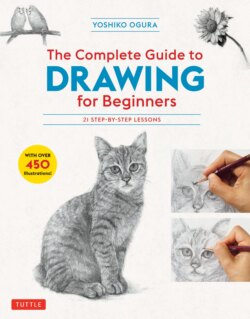Читать книгу The Complete Guide to Drawing for Beginners - Yoshiko Ogura - Страница 14
На сайте Литреса книга снята с продажи.
ОглавлениеGetting Ready to Draw
Organize your tools before you start!
As with beginning any athletic activity, you need to warm up and get ready before drawing. It is import-
ant to get everything ready to use to reduce distractions while you are drawing. Here are some tips to
help you prepare.
Sharpening your pencil
Use a craft knife to sharpen your pencil
Use a craft knife to sharpen your pencil by hand—don’t
use a pencil sharpener for this task. The point of the pencil
should be trimmed to be longer than it would be if it was
being used for writing. This allows you to produce a finer
line. It also makes the side of the lead available for shading.
The only way to achieve this is to sharpen the pencil by hand.
You can also sand the point into shape using a fine grade of
sandpaper.
1
When sharpening your
pencil, hold it in your left
hand, and hold the razor in
your right hand. Support
the blade by pressing on
it with the thumb of your
left hand while you whittle
away from you with your
right hand. (If you’re left
handed, reverse the hands
described in the procedure
above.)
2
Rotate the pencil with your
left hand. Shave away at
the material, and try to
keep the shape of the point
acutely conical. Pare away
both the lead and the wood
as you go.
Tips on sharpening
the pencil
If you are too aggressive when sharp-
ening, the shape of the pencil will be
negatively affected, and the wood
portion will become asymmetrical.
You might even scratch the paper
when drawing because of the uneven
angles of your pencil. When you
sharpen the pencil well, it will be easy
to use. Put effort into sharpening
your pencils well.
If there’s too much unsupported
lead sticking out, it will easily snap.
If there’s too much wood and not
enough lead, you might scratch the
paper, so give plenty of attention to
the tip of your pencil.
14
